Quality of the Environment in Japan 1990
Chapter1. Environmental Issues In The Globalization Era
I. Expanding Scope of Environmental Problems
Human activity is bringing about significant changes in the global environment at an unprecedentedly fast pace. It is not an exaggeration to say that the survival of human society itself is threatenedby changes in the composition of the atmosphere which hems in around the globe and the rain which falls on the ground surface and in the amount of greenery which embraces the land.
Not all those changes have begun recently. The expanding scope of human activity--notably, since the Industrial Revolution--has stead-ily overweighted the global environment. Besides, things have been made all the more serious due to an epochal expansion of the global economy and increases in population since World War II. The condi-tions of the global environment have been made clear through the continuous observation and surveillance performed by the U. N. Envi-ronment Programme (UNEP), which was established according to the decision of the U. N. Conference on the Human Environment in 1972, and by the World Meteorological Organization (WMO) and the World Health Organization (WHO).
Given those developments, the world has taken an increasingly great interest in the global environment in recent years, and there is a widespread recognition that it should begin to act in concert for the future generation.
Sharing more than 10 percent of the world economy, Japan depends on the globe for many resources in evolving its activities and imposes a wide variety of burdens on it. The nation is also equipped with precious experience and technology in the sector of environmental protection, which center on measures against pollution. For preserva-tion of the global environment, an important task for Japan is to play a positive role commensurate with its international position.
In this section, an attempt will be made to make clear what sorts of developments there have been in the world in recent years over the global environment issues, how they are dealt with and how the Japanese government copes with it. Later, an attempt will be made to make clear the circumstances in which various global environmental issues are placed and how they are tied in with one another.
1. Trends in Japan in the World Over the Global Environment
The year 1989 turned out to be the year when Japan and other countries took a great step forward in working for conservation of the global environment. In the following, let us take a look at domestic and world trends in the last year over the global environment.
(1) World Trends
In 1989, as it was keenly felt around the world that theworld environment stood on the verge of a grave crisis, there was agreement that the world would have to act in concert toward sustainabledevelop-ment and a great step forward was made in coming out with a frame-work of international cooperation. Since 1989, there have beenthe following international consultations to form an internationalconsensus (Table 1-1-1).
a. Environmental Summit in the Hague
In March 1989, a summit was held in the Hague, the Netherlands, under the cosponsorship of the French, Dutch and Norwegian prime ministers to discuss how to internationally cope with global warming, and the Japanese government was represented by the Director-General of the Environment Agency.
On the basic recognition that "today, the very conditions of life on our planet are threatened by the severe attacks to which the earth's atmosphere is subjected" and that solutions could be found only with cooperation at a global level, the summiteers came out with the Hague Declaration which contained, among others, a strengthening of the institutional capacities which would make it possible to work out effective decisions concerning the implementation of measures against global warming.
b. First Meeting of the Conference of the Parties to the Vienna Convention for Protection of the Ozonosphere
The Vienna Convention for Protection of the Ozone Layer (here-inafter referred to as the "Vienna Convention") was adopted already in 1985, under which the Montreal Protocol on Substances that Deplete of the Ozone Layer (hereinafter referred to as the "Montreal Protocol") was adopted in 1987. They went into effect in September 1988 and January 1989, respectively. The Vienna Convention obligates the parties to take appropriate measures for protection of the ozone layer and provides for cooperation in research and the exchanges of information, among others. Under the Montreal Protocol, it is obligated to reduce the output and consumption of CFCs, which readily destroy the ozone layer, to less than 100% a year from July 1989, to less than 80% a year from July 1993 and to less than 50% a year from July 1998 from the 1986 levels. It is also obligated to freeze the production and consumption of specified halons at the 1986 levels from January 1992.
Table 1-1-1 Major International Conferences on Global Environment Since 1988
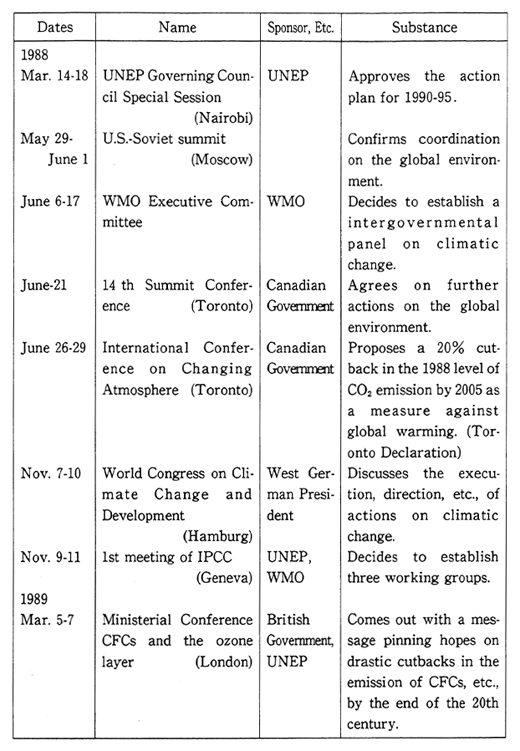
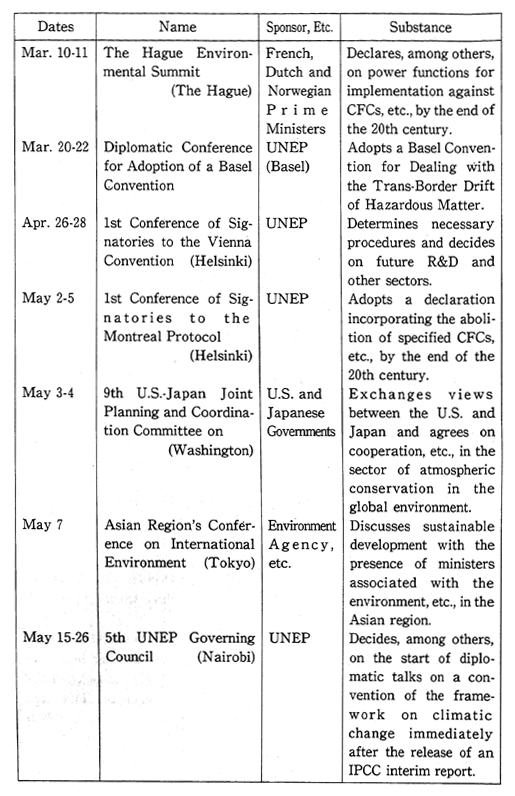
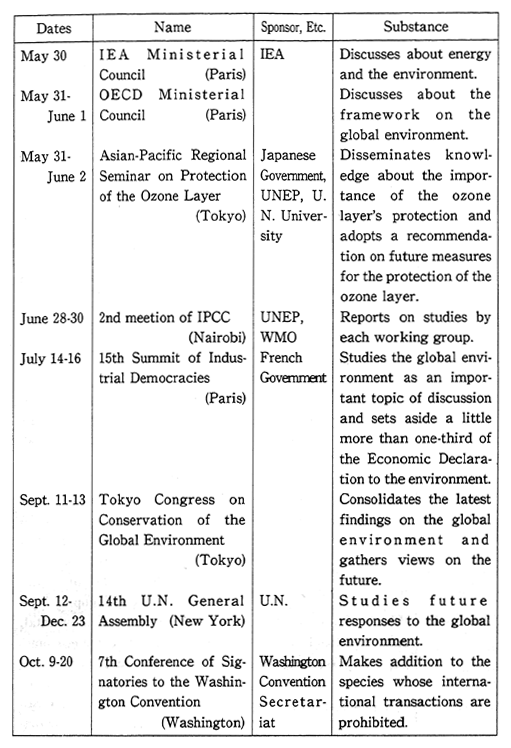
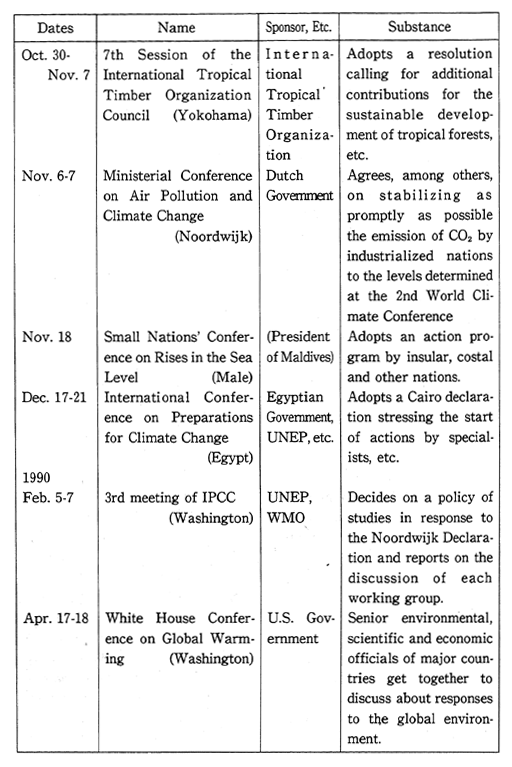
From the latest scientific findings, it was highly suspected that that control schedule would not be good enough to protect the ozone layer, and the Ministerial Conference on CFCs and the Ozone Layer (London Conference) was held in March 1989 under the cosponsorship of the government of the U. K. and the UNEP, and the Chairman's message was prepared that all industrial democracies were expected to drasti-cally reduce CFCs, which were subject to controls, by the end of the 20 th century.
In this circumstance, the First Meeting of the Conference of the Parties to the Vienna Convention was held in Helsinki in late April 1989 and the First Meeting of Conference of the Parties to the Montreal Protocol a monthlater.
The First Meeting of Conference of the Parties to the Montreal Protocol focused on more strict controls on CFCs and replenished aid to developing countries. The participating nations adopted the Helsinki Declaration under which it was agreed to totally abolish specified CFCs, etc. by the end of this century. The main items agreed on under the declaration follow
(a) The countries which had yet to participate in the Vienna Conven-tion and the Montreal Protocol would be asked to become parties.
(b) Specified CFCs would be entirely abolished by the year 2000 at the latest.
(c) Halon would be totally abolished and other substances that deplete the stratospheric ozone layer controlled and reduced as far as possible.
(d) Each party would do everything in its power to develop substi-tutes and alternative technology.
(e) Efforts would be made to offer information and opportunities for training to developing countries. Efforts would also be made to work out a framework for appropriate financial aid to promote technology transfers, etc.
A working group was organized to prepare the draft of a protocol on strengthening controls and other matters and to work on a mecha-nism for financial support to developing countries, and studies are under way for the Second Conference of the Parties to the Montreal Protocol which is scheduled to open in June 1990. At this meeting, plans are afoot for the adoption of a draft revision of the protocol which would call for a total ban on specified CFCs.
c. UNEP Governing Council
The UNEP Governing Council, the UNEP's highest decision-making body, meets twice a year. At its 15th meeting held in May 1989, it was decided that diplomatic talks about a framework convention should be started, immediately after the release of an interimreport of the Intergovernmental Panel on Climate Change (IPCC) which was scheduled in the fall of 1990, and that the UNEP should make prepara-tions for it with the cooperation of the WMO.
It was also decided to hold a U. N. Conference on the Environ-ment and Development in 1992, the 20th anniversary of the U.N. Conference on the Human Environment, and take up global warming, protection of the ozone layer, forest conservation, conservation of biodiversity as the main environmental issues and to work out strat-egies for protection of the environment at regional and globallevels. It was agreed on the presentation of a report on the results of technical and legal studies to the preparatory committee for the U.N. Conference on the Environment and Development in order to come out with anew legal framework, including a convention on the conservation of biodiversities on the globe.
Based on those resolutions, it was formally decided at the U. N. General Assembly in December 1989 to hold the U. N. Conferenceon Environment and Development in Brazil in 1992.
d. Arche Summit
At the summits attended by the top leaders of seven industrial democracies and the head of the European Community (EC), attention was focused on the protection of the global environment in their eco-nomic declarations since the Ottawa Summit in 1981. The summit of Arche held on the outskirts of Paris in July 1989 turned out to be epochal in the sense that over one-third of the Economic Declaration was devoted to the global environment as a main subject.
The declaration says, "Scientific studies have revealed the exis-tence of serious threats to our environment such as the depletion of the stratospheric ozone layer and excessive emissions of carbon dioxide and other greenhouse gases which could lead to future climate changes. Protecting the environment calls for a determined and concerted inter-national response and for the early adoption, worldwide, of policies based on sustainable development."
The summiteers agreed on various basic principles on the protec-tion of the global environment, such as by stating "We urge all countries to give further impetus to scientific research on environmental issues, to develop necessary technologies and to make clear evaluations of the economic costs and benefits of environmental policies. The persisting uncertainty on some of these issues should not unduly delay our action." On global warming, it says "··· the conclusion of a convention on climate change to set out general principles or guidelines is urgently required. ···"and "specific controls containing concrete commitment could be fitted into this framework as scientific evidence requires and permits."
At this summit, Japan globally expressed its will to expand and replenish bilateral and multilateral aid in the environmental sector in the next three years with the target set at ¥300 billion (about $1.25 billion) with a view that it would be crucial to support efforts of developing countries to protect their environment in coping with the global environment problems.
e. Tokyo Conference on the Global Environment and Human Response toward Sustainable Development
In September 1989, the Tokyo Conference on the Global Environ-ment and Human Response toward Sustainable Development was held under the auspices of the Japanese government. Of all global environ-ment problems, global warming, deforestation of tropical forests and environmental pollution in developing countries were taken up as priority study subjects, and the conference was held with the participa-tion of opinion leaders from 23 countries around the world to gather the latest scientific findings and to make proposals on actions the world should take. In the chairman's summary of the results of the discussions, it was pointed out that research work and monitoring are indispensable for reducing uncertainties about the global environment, that there is the need to establish an "Environmental Ethics," including a change of the ways of life in every country, that a revolutionary approach is required to make international funds for the sustainable development of developing countries, and that the UNEP and other organizations must be strengthened to evolve such international cooperation. It was decided to make full use of the achievements of this conference as important reference materials for subsequent international conferences.
f. Seventh Conference of the Parties to Washington Convention
The Convention on International Trade in Endangered Species of Wild Fauna and Flora (Washington Convention) was concluded in 1973 and entered into force in 1975 to conserve wildlife by controls on international trade in wild fauna and flora. It went into effect for Japan in 1980. Under this convention, a ban is put on international trade for commercial purposes of fauna and flora, listed in Annex I, which are threatened with extinction and adversely affected by trade. As regards fauna and flora, listed in Annex II, which are not necessarily threatened with extinction at present but which are likely to be extinct unless strict restrictions are imposed on trade, it is stated that international trade for commercial purposes is feasible but the export licenses issued by the governments of exporting countries are required. Nonetheless, reserva-tions can be made for some reason or the other even on species subject to restrictions (with the countries treated as a State not a party on the subject species).
At the Seventh Conference of the Parties to the Washington Convention held in Lausanne, Switzerland, in October 1989, ivory was taken up as a major issue and it was decided to move all African elephants from Annex II to Annex I. Agreement was reached on the transfer of coelacanths and all species of the genius of Papahiopedilum in the family of orchids from Annex II to Annex I. Of the 11 species of fauna and flora for which it had exercised the right to reservation, Japan expressed its withdrawal for estuarial crocodiles by the end of November 1989 and stated that it had a policy of doing so for Indian monitors (Lygosomma indicum) and red-tailed monitors by the next conference of the parties to the convention. It was also decided that the next conference would be held in Japan in the spring of 1992.
g. Noordwijk Conference
In November 1989, the Ministerial Conference on Air Pollution and Climate Change was held in Noordwijk on the outskirts of the Hague, the Netherlands, under the auspices of the Dutch government with the participation of the environment ministers of 67 countries, including not only those of Japan and other summit-member countries but those of the Soviet Union, East European countries, China,India and other developing countries, and also delegates from 11 international organizations. Recognizing that global warming, should it be left as it was, would be a grave problem which would threaten the future of the earth, the meeting was held to encourage each country of the world to cooperate in stepping up measures against global warming.
The results of this conference were incorporated in the Noordwi-jk Declaration on Air Pollution and Climate Change. The following statements were included in the declaration
(a) Assuring a stable development of the world economy and recogn-izing the necessity of stabilizing emissions of carbon dioxide and other chemicals with greenhouse effects, industrialized countries agreed to achieve the stabilization as early as possible at levels which were to be studied by the IPCC and at the Second World Climate Conference in November 1990. Many industrialized countries were of the view that the stabilization of carbon dioxide should be achieved as the first phase by the year 2000 at the latest.
(b) To balance forest decreases and increases on a global scale and make it a temporary target to work for a net increase of 12 million hectares a year in the area of forests around the world, the participating nations would ask the IPCC to make a feasibility study on this target.
(c) On the offer of financial aid to developing countries, further studies should be conducted on the mechanism for the offer of additional funds, including the concept of a clearing house (the mechanism of mediation between the donor and the recipient nations) and the possibil-ity of a new international fund, while making use of the existing mechanism for financial aid.
(d) All possible efforts should be exerted so that a convention on the framework of climate change could be adopted, if possible in 1991, or in 1992 at the latest, when a U. N. Conference on Environment and Development was to be held.
The meeting served to encourage a great leap forward in mea-sures against global warming, as industrialized countries agreed to stabilize emissions of greenhouse gases to levels which were to be studied at the Second World Climate Conference in November 1990 and a specific target was set for a recovery of the forest area.
At the Third IPCC Meeting in February 1990, it was decided to incorporate the findings of the studies it had been asked to make by this Declaration in an interim report it planned to complete by August.
In the wake of these international developments, important inter-national conferences are scheduled to be held one after another (Table 1-1-2). In those developments, the U. N. Conference on the Environment and Development in 1992 is considered a turning point, and discussions are under way with counsel and advice sought from around the world to work out a framework of international cooperation.
(2) Japanese Government's Approach
a. Establishment of Ministerial Council on Conservation of Global Environment Conservation
In regard to measures to cope with environmental problems which have grave impacts on the global environment, the government decided on May 12, 1989, to establish a Ministerial Council onthe Global Environment Conservation and have it meet to ensure close contact among the related administrative organizations and work for an effective and comprehensive implementation of those measures.
On June 30, the council held the first meeting and arrived at the agreement "On Measures for Global Environment Conservation."
In the agreement, it was agreed that Japan, which is closely related to the global environment through its extensive economic activ-ities, and has advanced technologies in the environmental pollution control and other sectors--when global environment issues havecome to the fore and there are mounting calls for measures to cope with them --should play a more positive role commensurate with its international position. The council presented the following six items as thebasic principles Japan should follow for the time being:
(1) To positively participate in formulating an international frame-work for protecting the global environment and promote measures from a global viewpoint.
(2) To promote the observation/monitoring and researches of the global environment in order to expedite the formulation of thebasis for global environmental protection through scientifically understanding the effects of various human activities on the global environment.
(3) To pursue the development and transfer of technology for global environmental protection, thus contributing to the various international efforts.
(4) To make efforts for an expansion of official development assis-tance (ODA) for environment protection, the development and transfer of appropriate technology for developing countries and the training of human resources in the environmental sector, etc.
Table 1-1-2 Scheduled Major International Conference on Global Environment
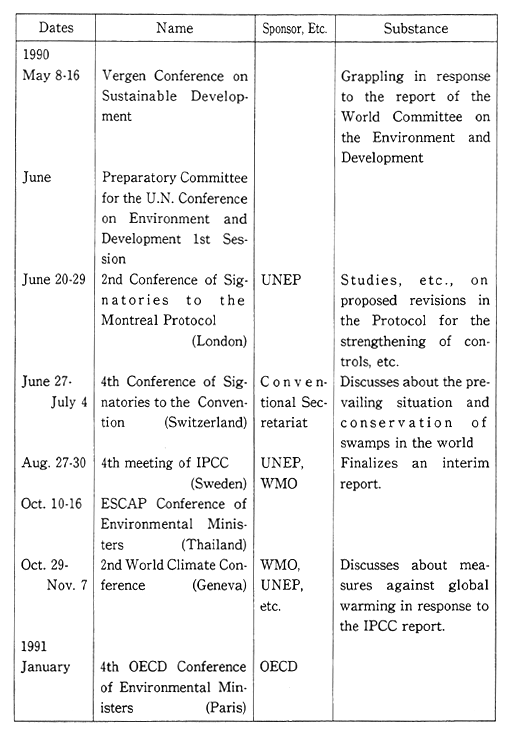
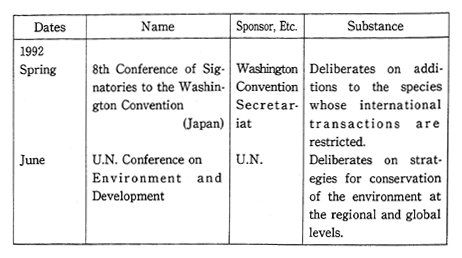
(5) To strengthen environmental consideration as for the implemen-tation of ODA.
(6) To ensure that the economic activities are carried out in a manner which has less burden on the global environment, such as the promotion of resource conservation and saving energy and to promote awareness and education in each segment of the people.
In solving the problems associated with the global environment, it is necessary to accumulate scientific findings in a long-term perspective, and it is necessary that Japan should take the lead in the world in striving for the accumulation of scientific findings with close coopera-tion with researchers both in Japan and abroad. From this point of view, the Ministerial Council met for the second time on October 31 and came to an agreement "On the Comprehensive Promotion of Research, Observation/Monitoring, and Technology Development for the Conser-vation of the Global Environment." It is designed to realize the second and third items incorporated in the agreement of the first meeting and they read as follows:
(1) To promote researches with a positive participation in interna-tional research cooperation programs on the global environment ; to promote observation and monitoring, such as by introducing the wide-ranging observation and monitoring of the atmosphere, oceans and ecosystems, observation and monitoring via satellites and strengthening networks for international observation and monitoring; and to promote technology development in various sectors in cooperation with the private sector.
(2) For a steady promotion of those measures, the Ministerial Coun-cil will decide on a comprehensive promotion plan on researches, observation and monitoring and the development of technology in each fiscal year. Given reports on the implementation of this program and its results, the Environment Agency will serve as a general information contact office and the related ministries and agencies will also assign their respective contact office for information on global environment conservation.
b. Assignment of Minister in Charge of Global Environmental Problems
In order to coordinate the works of all ministries and agencies concerned and to promote a smooth implementation of measures to cope with global environmental problems, the government decided on July 11, 1989, to assign a Minister in Charge of Global Environmental Problems, who would take charge of the coordination of administrative work carried out by ministries and agencies related to global environ-mental problems. The post has since been concurrently assumed by the Director-General of the Environment Agency.
As a means to coordinate administrative work carried outby various ministries, the minister compiled a fiscal 1990 budgetfor global environment conservation for the whole government.
This budget reflects the positive policy efforts made by the related ministries and agencies on the basis of the Ministerial Council' s agreement to which reference has been made earlier. It amounted to ¥452.3 billion, up 6.3% from the previous fiscal year. Of this total amount, the expenditure for policy was ¥600 billion, a marked rise of 35. 9% from the previous fiscal year.
2. Expanding Scope of Global Environmental Problems
(1) Global Warming
As trace gases in the atmosphere absorb the infrared rays radiat-ed from the ground surface and keeps in the atmosphere the heat which is to escape into space, the temperature of the atmosphere and the ground surface is kept warm to keep it favorable for the survival of creatures. This phenomenon is called a greenhouse effect, and the gases which absorb infrared rays are known as greenhouse gases. They include water vapor (H20), carbon dioxide (CO2), chlorofluorocarbons (CFCs), methane (CH4), tropospheric ozone (03) and nitrous oxide (N20), among others.
Global warming represents a danger that as man's activity leads to rises in the concentration of those greenhouse gases, there will be increases in greenhouse effects, thus sharply raising the atmospheric temperature in the next several decades. As the temperature goes up, there will presumably be rises in the sea level and changes in the pattern of precipitation and the volume of evaporation, thus producing grave impacts on ecosystems and human society which are closely tied in with the climate. First, when the temperature goes up, the sea level will go up because of the swelling of seawater and the melting of ice on the land, thus inundating coastal areas and giving rise to erosion. That means that grave impacts will be produced on coastal cities around the world, the estuaries of the Nile in Egypt and the Ganges in Bangladesh and the Maldives and other countries perching on coral islands.
Agricultural products will also be gravely affected by changes in the volume and time of precipitation, hazards from high temperature, changes in the generation of blight and also in soil humidity. As the ecosystems of fauna and flora are closely associated with the climate, it is conceivable that they will be unable to put up with sudden climate changes, vegetation dilapidated and the extirpation of species accelerat-ed. Due to changes in the distribution of infections tied in with the climate and other factors, there is concern that man's health might be adversely affected. Besides, the influences will presumably be broader and more diversified, such as increases in the frequency of floods and typhoons, the melting of the tundra and the loss of snow and other sightseeing resources.
The dimension of greenhouse effects per concentration of green-house gases varies, depending on their type and density. Some green-house gases other than carbon dioxide more strikingly and to warming than carbon dioxide when the concentration changes to a certain extent. With carbon dioxide at 1, it is calculated that the contribution to warming with an identical rise in the concentration from the prevailing level is about 10 times by methane, about 100 times by nitrous oxide, about 1,000 times by tropospheric ozone and about 10,000 times by chlorofluoro carbons. From the standpoint of contributions to warming, carbon dioxide produces the greatest impact in that its concentration in the atmosphere is higher than that of other greenhouse gases. Nonethe-less, the contributions made by greenhouse gases other than carbon dioxide rise year by year, and their combined contributions are virtually the same as those of carbon dioxide (Fig. 1-1-3).
Here, a check of the measured values of carbon dioxide concen-trated in the atmosphere reveals that its concentration has been on the upswing as coal, oil and other fossil fuels have been consumed in massive quantities and forests have been on the decrease since the Industrial Revolution. From an analysis of the air sealed in the Antarc-tic ice, it is surmised that the concentration was stable at 280 ppm or so before the Industrial Revolution, but in an estimate for Mt.Mauna Loa on Hawaii Island, it stood at about 320 ppm in 1960 and about 350 ppm in 1989 (Fig. 1-1-4).
Fig. 1-1-3 Contributions by Greenhouse Gases to Global Warming
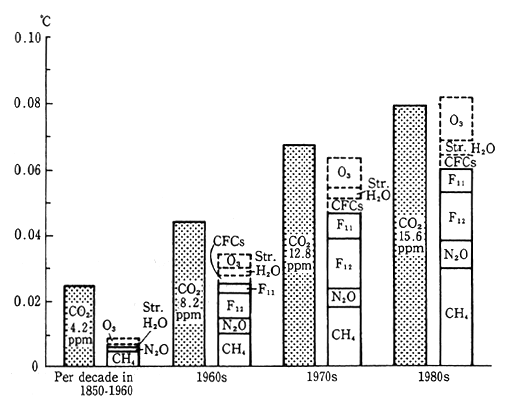
Note Increases in greenhouse gase concentrations are expressed in terms of rises
(theoretical values) in the average global surface air temperature. Hansen etal., 1988.
As much energy comes from the combustion of fossil fuels, emissions of carbon dioxide will continue in proportion to energy consumption, if nothing is done about it, and the concentration of carbon dioxide will continue to rise. Other greenhouse gases are also on the increase. Methane is generated in swamps, lakes and marshes, paddy fields, the digestive organs of cattle and other animals, the activities of microorganisms at waste disposal yards and the production of naturalgas and other fossil fuels, among others, and their concentration in the atmosphere has almost doubled in the last 200 years, still rising at a rate of about 1% a year. Increases in the artificial sources of generation and in the artificial emission of carbon monoxide and other chemicals which deter the dissolution of methane in the atmosphere are presum-ably responsible for the rise in the concentration (Fig. 1-1-5).
Fig. 1-1-4 Trends in Carbon Dioxide Concentration and Temperature
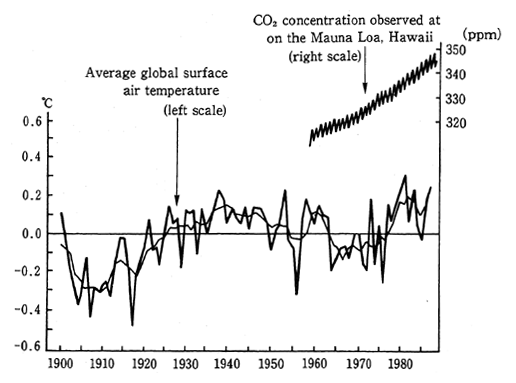
Notes: 1. The average global surface air temperature indicates deviations from the normalized year's value (mean in 1951-80). The bold lineshows the annual mean, and the thin line indicates the running average for five years.
2. Source: The U.S. Environmental Protection Agency's Report.
As regards nitrous oxide, soil, oceans, the depletion of forests, the utilization of nitrous fertilizer and the combustion of fossil fuels, among others, are considered as the sources of its generation, and the concen-tration in the atmosphere rises at a rate of about 0.3% a year. In respect of chlorofluorocarbons (CFCs), as we have seen earlier, there are moves for its total abolition, but now that it is so extremely stable a greenhouse gas in the troposphere that even after it is totally aboli-shed, it will take a considerable length of time for its concentration in the atmosphere to drop. Should substitutes for CFCs be used, there will be concern about the impacts produced by their greenhouse effects. If it is assumed that greenhouse gases will continue to increase at the present pace, the concentration of all greenhouse gases will be twice that of carbon dioxide before the Industrial Revolution by 2030 and will accelerate later.
Fig. 1-1-5 Trends in Methane Concentrations in Atmosphere
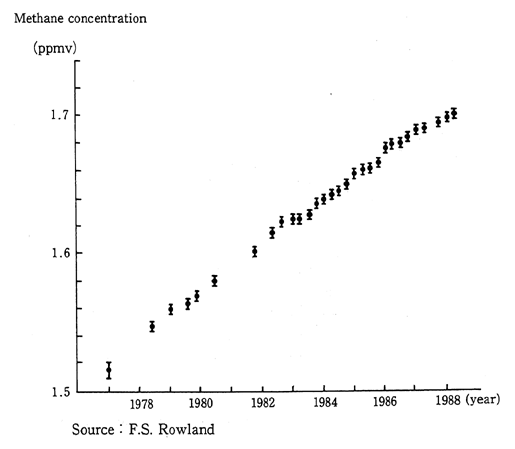
On the impacts of this density, the Greenhouse Gas Study Panel of the Council on Climate Problems in the Meteorological Agency says in its report on climate changes by increased greenhouse gases that if the density of greenhouse gases continues to increase at the present pace, global mean temperature will rise by 1.5-3.5? and the sea surface by 20-110 centimeters. In respect of the future prospects of global warming, some aspects have to be made clear about periods of rises in temperature, but it is a common recognition that global mean tempera-ture will rise by several degrees, and in some regions by higher degrees, in less than half a century.
As regards the mechanism for climate change, it is asserted that about 58% of about 5.5 billion tons of carbon dioxide (in terms of carbons) generated by the combustion of fossil fuels, for example, is equivalent to an increase in the concentration of carbon dioxide in the atmosphere, but concentrated studies are being made around the world and there is the need to deepen scientific findings to a further extent about clarification of the absorption mechanism of the concentration of its remaining percentage (Fig. 1-1-6). clarification of the behavior of a wide variety of greenhouse gases in the atmosphere, clarification of the generation of clouds and its impacts, accurate estimation of the evapo-ration and dispersion of water on the land, and the combination of the major oceanic circulation with atmospheric models with consideration given to circulation in the deep parts of oceans.
But the impacts brought about by global warming on ecosystems, the world's economic performance and human life, among others, are indeed enormous. It would be impossible to immediately reduce green-house gases in the atmosphere if measures were not taken till a clear recognition of the effects produced by global warming. It would also be extremely difficult to reverse the climate change and the sea level rise, once they took place. This implies that the measures are to be initiated immediately, even though the uncertainties exist, or the irreversible impacts are rise. As was advocated in the Arche Summit Declaration, therefore, our action must not be unreasonably put off simply because there remain some uncertainties, and it is important to carry out necessary measures before it is too late.
Fig. 1-1-6 Carbon cycle in Biosphere, Atmosphere and Oceans
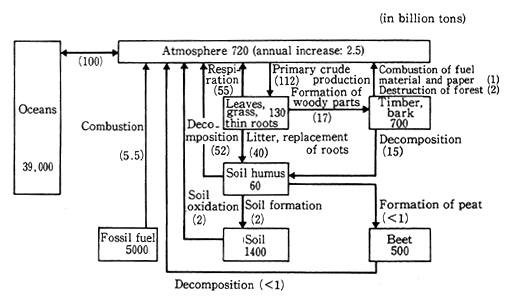
Source EPA "Policy option" 1989, Bolin 1983.
There is a mounting recognition in Japan and elsewhere in the world about the serious nature of global warming, and researches and studies on measures have been energetically made.
First, in the Intergovernmental Panel on Climate Change (IPCC), which was established with the cooperation of the U. N. Environment Programme (UNEP) and the World Meteorological Organization (WMO), three working groups were organized for studies and discus-sions from the standpoint of experts, and their work has been under way since the IPCC held the first meeting in November 1988. The First Working Group evaluates scientific findings on the mechanism predic-tion and uncertainties of climate change. The Second Working Group studies the environmental impacts brought about by climate change and the social and economic impacts, including agriculture, water resources and energy. The Third Working Group studies policy and strategy to cope with climate change, such as legislation, technology transfer, and financial, educational and economic measures. The findings of those studies will be compiled at the IPCC's plenary session in August 1990 into an interim report, which will be presented to the Second World Climate Conference from late October to early November.
In addition, the Hague Environment Summit, the UNEP Govern-ing Council's meeting and the ministerial conference in Noordwijk, among others, were held as we have seen earlier. Particularly at the Noordwijk conference, the necessity was recognized of stabilizing the greenhouse gas emissions while assuring a sustainable development of the world economy.
(2) Depletion of the Ozone Layer
Atmospheric ozone is generated on the basis of oxygen released by photosynthesis over a time span of about three billion years, and much of it exists in the stratosphere as the ozone layer, playing an exceedingly important role in absorbing almost all ultravioletradiation from the sun which is harmful to life. In recent years, there has been an increased fear that these ozone might be depleted by CFCs and other chemicals. CFCs have been extensively used for solvents, refrigerants and foaming agents, among others. But as they are stable to chemical attacks, they will reach the stratosphere, instead of being removed in the troposphere, after they are used and emitted into the atmosphere. In the stratosphere, they are decomposed to release chlorine atoms by intense solar ultraviolet radiation. The released chlorine atom then decompose ozone catalytically via chain reaction, leading to the deple-tion of the ozone layer.
CFCs are broadly used, because they are nontoxic, nonflammable, quite ready to melt oil and stable to chemical attacks. Japan consumed about 133,000 tons of CFCs in 1986, accounting for a little more than 10% of the world's consumption. Beside CFCs, halons, methylchiorofor-m and carbon tetrachloride pose issues as substances which deplete the ozone layer. Halons are used for fire-extinguishing and other agents, and though their consumption is smaller than that of CFCs but their ozone depleting potentials are by far greater. Methylchloroform, though its ozone depleting potentials are smaller than that of CFCs, is con-sumed in large quantities like CFCs.
When the stratospheric ozone layer is depleted and the ultraviolet radiation increases, a wide variety of impacts is brought about on man, fauna and flora and materials (including synthetic resin), such as adverse effects on the growth of farm products and on marine eco-systems with plankton affected, in addition to adverse impacts on man' s health, such as increases in the incidence of skin cancer and cataract.
There has been remarkable progress in scientific findings about depletion of ozone in the stratosphere in recent years. First,as for the conditions of ozone over the polar regions, the phenomenon in which the concentration of ozone over the Antarctic decreases rapidly in the early spring of every year, or the ozone hole, is observed. Over the Arctic, too, it is found that there is a possible rapid decrease in the concentration of ozone. In regard to global ozone trends, it has been confirmed that the total ozone has decreased by 3-5.5% in the Northern Hemisphere(30-64ー N.) in the winter over the two decades that stretched from 1969 to 1988. The causes of this ozone decrease cannot be expatiated upon with ordinary natural phenomena, and it is confirmed that the increase of CFCs and other chemicals concentrated in the atmosphere is at least a partial causative factor (Fig. 1-1-7 and Fig.1-1-8).
Given those increasing findings, international efforts have been made as we have seen earlier. As there is the need to take account of a wide variety of elements, it is difficult to make quantitative assess-ments, but the conclusion has been basically reached that gains from the phaseout of specified CFCs are greater than loses, and the development of substitutes is being stepped up to early phase out CFCs.
The parties to the Vienna Convention and the Montreal Protocol consist of 54 countries and the European Economic Community (EEC) and 48 nations and the EEC, respectively, including Japan. In the future, it is important for each country to promote a better understanding about the Vienna Convention and the Montreal Protocol and increase the number of parties so that a wide variety of measures may be promoted in a global dimension.
Fig. 1-1-7 Changes in Total Volume of Ozone at Lat. 30-34 Degrees N.
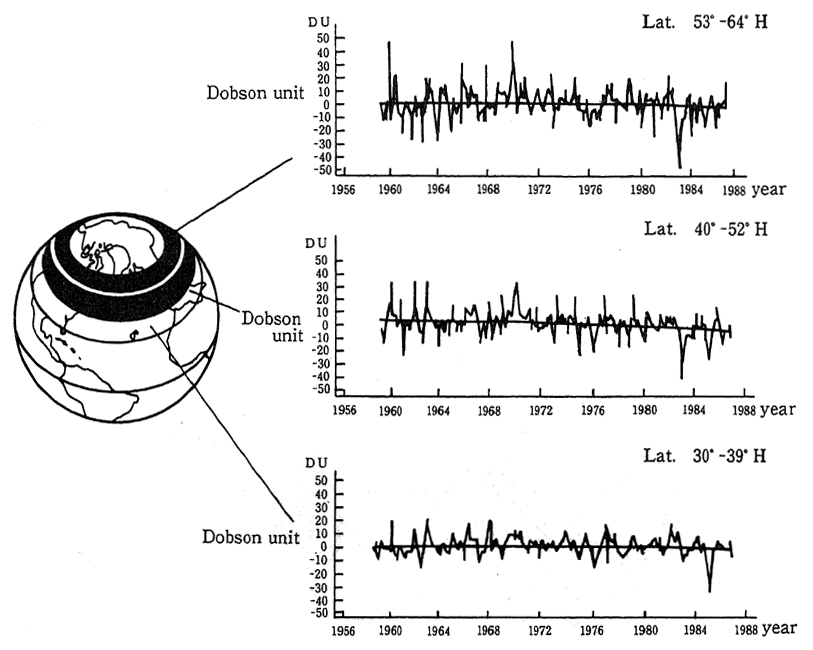
Note This figure shows trends in the value of the total volume of ozone by the Obson spectrometer, averaged for each belt of latitudes. Eliminated are seasonal changes and QBD (changes in a cycle of quasi-two years), changes in the solar cycle and the effects of nuclear tests. The trend is indicated with solid lines on the assumption of no changes before 1970 and linear changes later. (UNEP/WMO Scientific Panel's Report)
Fig. 1-1-8 Antarctic Ozone Holes
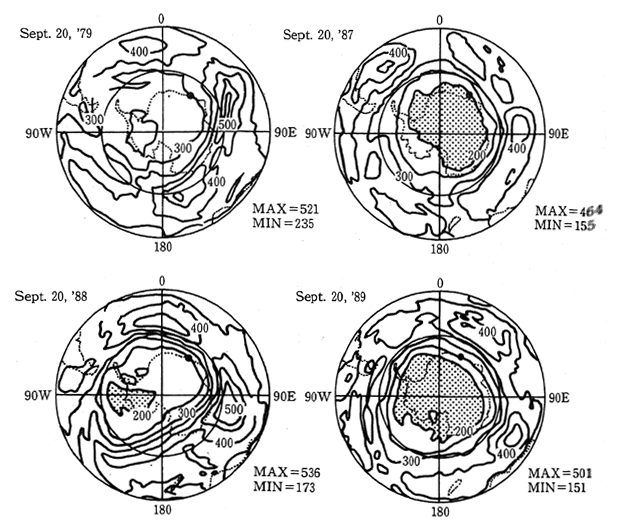
Unit: Dobson unit
Note: The dots indicate the location of the Showa Antarctic Base. The outer latitudinal circle represents lat. 30 degrees S. and the inner represents 60 degrees, S.
(3) Acid Rain
The acid rain primarily represents the type with less than 5.6 in pH (hydrogen ion concentration), which is presumably generated by taking in sulfur oxides, nitrogen oxides and other air pollutants. The acid rain is of such a nature that it also falls on areas as far as several thousands of kilometers away from the sources of air pollutants, posing serious problems in Europe and North America as those of air pollut-ants migrating over long distances across national borders (Fig. 1-1-9). A check of the fall of sulfur oxides on each European country reveals that more than half of the sulfur oxides which generate in many countries fall on other countries.
The damage brought about by the acid rain includes direct impacts on agricultural products by its direct fall on their leaves ; impacts on forests with their roots spilled by the melting of noxious metals as a result of soil acidification and other phenomena ; the acidification of lakes, marshes and rivers by the inflow of the acid rain ;and the decrease of fish in those waters, thereby having grave impacts on the ecosystem.
Fig. 1-1-9 Concentrations of pH, ion sulfate, etc. in European Pprecipitation
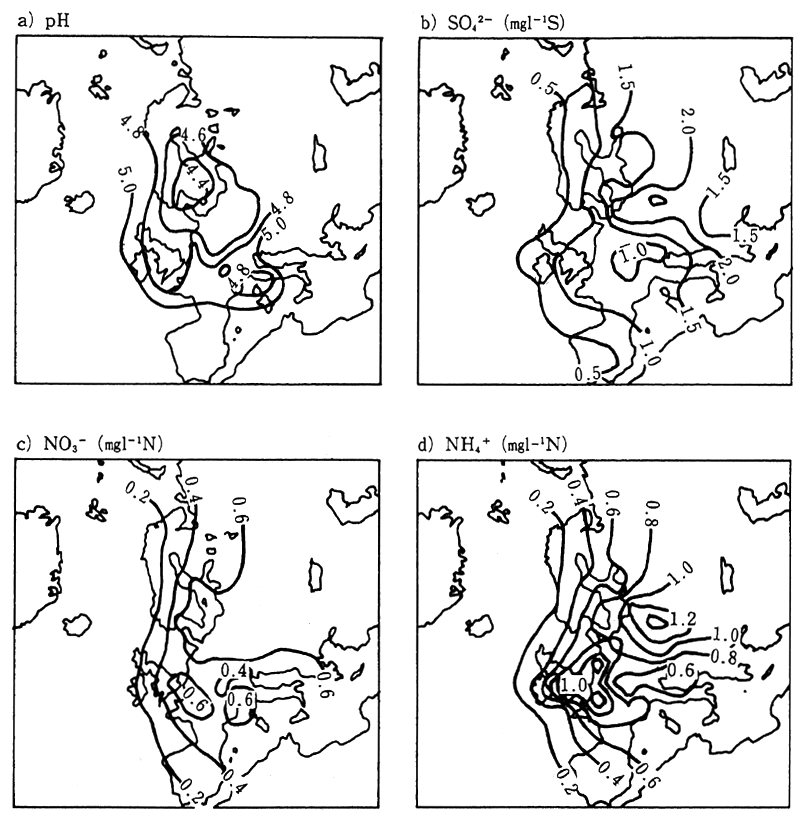
Source: UNEP data
It is reported that more than half of the forests in many European countries are affected by the acid rain (Fig. 1-1-10). It is also confirmed that lakes, marshes and rivers are acidified in Belgium, Czechoslovakia, Finland, West Germany, Italy, the Netherlands, Norway, Sweden, the United States and Canada. In the south of Norway and Sweden, lakes and marshes are acidified. In the south of Norway, 70% of the lakes and marshes are acidified and the number of fish decreases, thus making their extinction possible.
In attempts to cope with the damage caused by the acid rain, Western nations concluded a Convention Against Long-Distance Air Pollution Across National Borders in 1979, and it was incorporated in a protocol to this convention at the Helsinki conference that the discharge of sulfur oxides be decreased by upwards of 30% from the 1980 levels. In 1988, furthermore, 25 nations became signatories to the Sofia Proto-col which called for freezing the discharge of nitrogen oxides in 1994 at the 1987 levels.
Fig. 1-1-10 Damage on European Forests by Acid Rain and Air Pollution
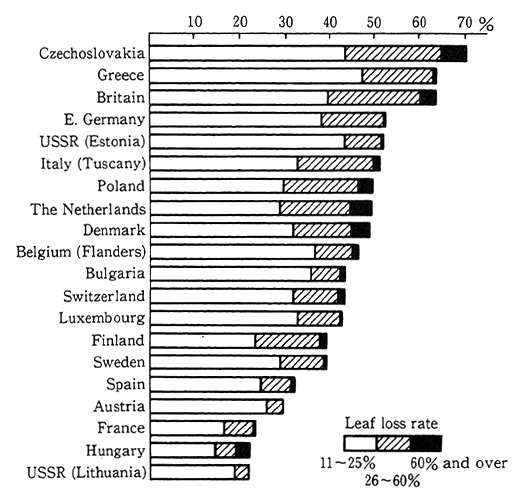
Remarks: Prepared from UNEP data. Surveyed in 1988.
Beside the theory that the acid rain is the primary cause to an atrophy of forests, it is propounded that the physiological function of plants is impeded and their growth directly checked as ozone and sulfur oxides are absorbed in their leaves, or that the cause is the nutrition disorder that results from an excessive supply of oxygen and a lack of other nutrient salts and an ensuing drop in the retrievability of plants to meteorological hazards and blight. But it does not necessarily follow that the mechanism for a degeneration of forests is clarified to the full.
But it is thought, nonetheless, that the mechanism for the degen-eration by the acid rain of forests is an outcome of the combination of the following phenomena. First, the fertility of soil drops as calcium, potassium, magnesium and other nutrient salts in the soil are drained out by the acid rain, on the one hand, and roots are impaired by the elusion of harmful aluminum and other metallic ions, on the other. As the vitality of microorganisms--particularly, bacteria--in the soil is deteriorated, the dissolution of organic matter is delayed and the circu-lation of matter is disturbed, the acid substances which stick to leaves make nutrient salts fall off the leaves.
The acid rain was taken up as a grave issue for the first time in Europe, but it was later found that it falls in China, too. Sometimes called kong zhong yu (midair demon), the acid rain which features a conspicuous acidity is generated particularly in the southwestern part of China. It is surmised that the primary cause is the release of sulfur oxides resulting from the massive consumption of coal which contains much sulfur.
(4) Deforestation, Particularly Tropical Forests
With details to be given in Section 3, the forest is not only a source for the supply of firewood and charcoal resources, fruits and the like but a habitat of birds and beasts, also functioning for the fostering of water resources and the prevention of landslides and other natural disasters. In recent years, moreover, the importance of forests has been reconfirmed as a sink of carbon dioxide which is a cause of global warming.
A check of the availability of global forest resources by region indicates, as shown in Table 1-1-11, that they are abundantly available in South America which embraces broad expanses of tropical rain forests, primarily in the Amazon basins, and in the Soviet Union where polar needle-leaved trees are extensively distributed. From Fig. 1-1-12, which shows increases and decreases, we are able to observe signs of a decrease in the availability of forests in Latin American, African and other developing countries, while the availability levels off in Western Europe and North America.
There is a mounting recognition of the preciousness of tropical forests, above all, which not only serve as a supply source of food and fuel to people in the tropical region but as a treasure habitat of biologi-cal species for the entire world, as it is estimated that tropical forests are inhabited by about half of them, and which are equipped to function as a moderator of the environment, such as an alleviator of the global climate. On the other hand, a grave issue is posed as it has become evident that they are rapidly decreasing.
In the category of tropical forests, forests in the tropical region are broadly dealt with. Beside closed forests of broad-leaved trees including mangrove trees, forests of needle-leaved trees and bamboo forests, they include open forests in Savanna and Indochina which mingle with African trees.
Table 1-1-11 Existence of World Forest Resources
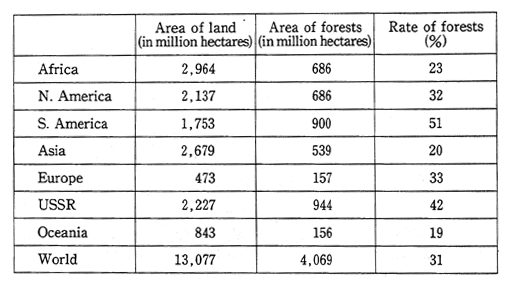
Source: FAO Output Yearbook
Fig. 1-1-12 Trends in Area of World Forests
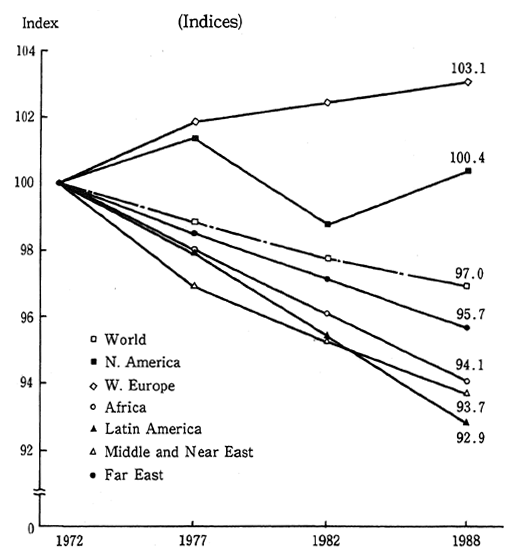
Source: FAO Output Yearbook
According to the results of a survey released in 1980 by the World Food and Agricultural Organization (FAQ), about 1,940 million hectares of tropical forests existed as of the end of 1980. including 900 million hectares in tropical America, 700 million hectares in tropical Africa and 340 million hectares in tropical Asia, but it was projected that they would reduce by about 11,300,000 hectares (which corresponds to the area of about half of the Honshu island of Japan) over five years from 1980. By region, the decrease would be 5.6 million hectares intropical America, 3.7 million hectares in tropical Africa and 2 millionhectares in tropical Asia.
"Deforestation" is defined as "the change or transfer offorest land for conversion into non-afforestation purposes" and the areas where felling is already done not for migratory cultivation isconsidered as areas of "degradation" but not of "deforestation" in the FAO report. It was projected in The Globe in 2,000 Years released by the U. S. government in 1980 that forests around the world were decreasing at an annual rate of 18-20 million hectares and that this net deforestation would remain at the same pace till the end of this century.
On the subsequent state of affairs, survey findings havebeen published by nongovernmental research institutes and research workers. The views expressed in the reports more or less vary, but it is observed in many reports that the deforestation is under way at a faster pace than predicted by the FAO. On the basis of satellite observation, it is made clear that the area of forests along the Amazon in Brazil in 1987 alone was down 8 million hectares, higher than the 5-6 million hectares projected in the early 1980s.
The causes to the decrease of tropical forests differ, depending on the region, but it is considered that the primary cause is slash-and-burn agriculture done in disregard of nature's recovering power. This farm-ing method is responsible for 70% of the decrease in closed forests in tropical Africa, 49% in tropical Asia and 35% in tropical America. In addition, excessive pasturage constitutes yet another cause in tropical America, whereas farming by settlers and the construction of dams and other facilities are defined as yet another contributory factor in tropical Africa. In tropical Asia, it is pointed out that the migration driven out of lowland to hinterland and a shift to the plantation of palm oil, rubber and the like are great in gravity.
According to a report from the U.N.Economic and Social Commission for Asia and the Pacific (ESCAP), the collection of fire-wood and charcoal and excessive pasturage in South Asia (including Bangladesh, Bhutan, Indonesia, Nepal, Pakistan and Sri Lanka) and slash-and-burn agriculture in the continental part of Southeast Asia (including Myanma, Thailand, Cambodia, Laos and Vietnam) are the primary cause of deforestation and degradation. On Southeast Asian islands (including Malaysia, Indonesia, the Philippines and Papua New Guinea), felling for commercial purposes is considered as the primary cause of the degradation of tropical forests or indirectly of deforesta-tion.
Slash-and-burn agriculture is generally a method in which migra-tion is made to other forests when a small area of forests is felled and burned and crops are planted by taking advantage of its rich fertility. Cultivation is carried out normally over a period of 2-3 years after the first year of cultivation. The area which has been cultivated and later abandoned gradually recovers as a forest, but a sabbatical period of at least 10 years is required before the soil fertility is recovered to the extent that cultivation is once again feasible.
Traditionally performed by sylvan peasants, this cultivation method has a history of upwards of 2,000 years in Southeast Asia. Nonetheless, the lack of cultivable land due to population increases primarily in developing countries in recent years, the decrease in land productivity due to slash-and-burn agriculture without an adequate sabbatical period (Fig. 1-1-13) and the further rise in the demand of cultivable land accelerate deforestation and give impetus to a depletion of forests.
This aerial photo taken from the communication satellite shows the deforestation in Thailand. The red parts of the photo are forests.

Farmers carry out slash-and-burn cultivation and move on.
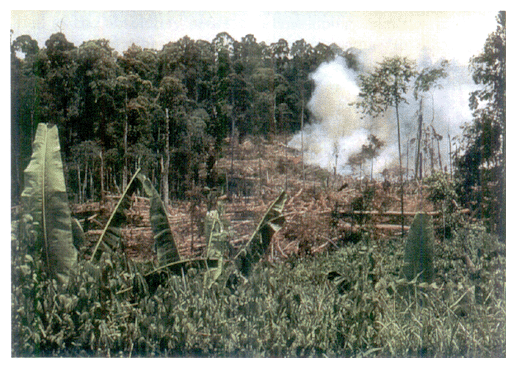
Typical marine mammals such as seals (photo, left) and sea otters (right)

These wildlife species are on the verge of extinction. Photo shows, from top left to bottom right, African ele-phants, rhinoceros, an Atlas moth, a Bengali tiger, a Siberain white crane and a giant Brazilian otter.
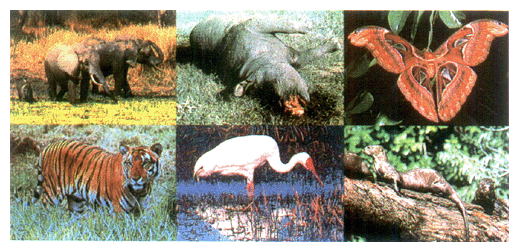
Fig. 1-1-13 Relations Between Non-farming Season in Slash-and-burn Farming and Productivity
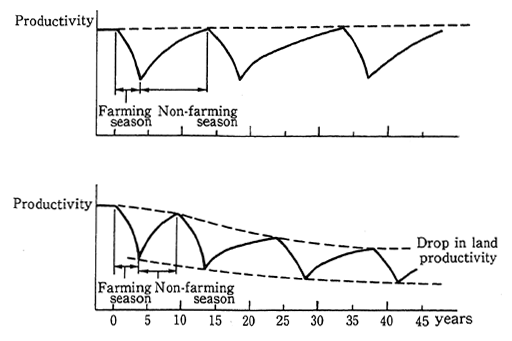
Source: AICAF, Slash-and-Burn Farming
It is projected that 90% of an estimated 780 million people classified as the absolutely poorest in developing countries (excluding those in China and other centrally planned economies in Asia) in 1980 were peasants, and 138 million households found themselves in a virtu-ally landless condition. Particularly in Latin America, 7% of the land under cultivation is concentrated in the hands of landlords, and millions of peasants are placed in a landless condition. As is discernible from poverty and other conditions in the rural areas, attention must be focused on the socioeconomic issues against the background of defores-tation in tropical forests, such as population rises, poverty and land distribution in developing countries.
It is not an easy task to clarify the area of degraded tropical forests, but fires are cited as yet another cause beside lumbering, the collection of firewood and charcoal and excessive pasturage. In respect of lumbering, the number of tree species of which tropical forests are made up is extremely large in general terms, and of those trees, only those marketable with certain diameters are felled, so that if full heed is paid to the regeneration of forests and other factors, deforestation and an excessive degradation will not be encouraged.
But according to the report on a tropical forest resource assess-ment project by the FAO, excessive felling is done and even trees of the sort the felling of which is not intended are adversely affected by the logging work in forests with a high density of useful trees, such as the mixed forests of tropical trees which center on the family of Dipterocar-pus. According to surveys in the Philippines and the state of Sabah, Indonesia, 14% of the land under development is cleared for transporta-tion by tractors and other machines. Serious adverse impacts also make their appearance, because there presumably are cases in which some of the useful trees in the primeval forests cease to exist due to excessive felling as it is difficult to work for their renewal after clearance of the forest land, and because a soil erosion takes place in the downland to encourage a landslide as plants are hard to grow once again in the barren, such as with tractors' furrows.
There are cases in which the development of roads for the takeout of lumber gives rise to infiltrations into the hinterland by peasants engaged in illegal cultivation, and it is pointed out that slash-and-burn agriculture done after logging in disregard of nature's recover-ing power is the primary cause for deforestation.
Then there is a drop in the availability of mangrove forests which grow in the intertidal zone between the tropical and the subtropical regions. Mangrove forests are indispensable for people in the subtropi-cal zone as fuels for cooking and building materials for houses, and there are many species which are usable as medicines. They also serve as hiding places for fingerlings at full tide and fallen leaves erode to become feed for plankton, thus serving as places of propagation for many marine organisms. Even in such useful mangrove forests, felling is done on a large scale for the development of paddy fields and the production of lumber and pulp resources for commercial and other purposes, and according to research and other institutions, it is project-ed that 1.6 million hectares of mangrove trees, or four times as much as at present, have been felled in India and 1 million hectares, or 2.5 times as much as at present, in Bangladesh. Also according to the ESCAP report in 1986 on the "Environmental and Socioeconomic Aspect of Tropical Deforestation in Asia and the Pacific," the raising of shrimps in cleared mangrove forests is a cause of the mangrove forest decrease in Bangladesh, Thailand and other countries.
Forests of the temperate zone in North America, Europe and other regions suffer severe damage due to air pollution and the acid rain as we have seen earlier. In North America, it is made clear that felling is done in excess of the growth of forest resources and there are mounting calls for the preservation of forests from the standpoint of conserving wildlife in forests, including West American owls.
(5) Desertification and Soil Erosion
Desertification represents a drop in soil productivity in dry and semi-dry areas around the world. It began to draw attention from around the world, as the drought that had begun in 1968 came to a peak in 1972-73 for the first-half period, giving rise to a striking devastation of the environment and to the death of many people and the appearance of refugees, and the first U.N.Conference on Desertification (UNCOD) was held in 1977.
The UNCOD was the place where the conditions of global deser-tification were made clear for the first time, and reports were presented on how desertification went on and was to begin in all dry, semi-dry and semi-humid areas around the world, and that 6 million hectares of land (which corresponds to the total area of Shik oku and Kyushu) were made barren due to desertification. Seven years later or in 1984, furthermore, a fact-finding survey was conducted to assess the implementation of the program adopted by the UNCOD against desertification. As a result of this survey, it was clarified (1) that the land impoverished by desertifica-tion remained increasing at an annual rate of 6 million hectares a year, (2) that the areas the net economic productivity of which was zeroed or made minus continued to rise at an annual rate of 21 million hectares a year, (3) that about 80% (3.1 billion hectares) of pastures, about 60% (335 million hectares) of farmland dependent on rainfall and 30% (40 million hectares) of irrigated farmland were adversely affected by intermediate levels of desertification, (4) that the total area of 3,475 million hectares of desertified farmland accounted for 75% of the total area of produc-tion (4.5 billion hectares) in the dry regions, and (5) that the rural population affected by a serious desertification had increased from 57 million in 1977 to 135 million in 1983 (Table 1-1-14).
Cited as artificial causes for desertification are excessive grazing (vegetation is destroyed due to consumption by cattle which exceeds the threshold of growth for plants, and the soil of barren land is lost by wind and water erosions), excessive cultivation, felling for firewood and charcoal and the accumulation of salts by an inappropriate irrigation, among others. Against the backdrop, there exist social and political affairs, impacts from the development of mining and manufacturing industries and other factors.
Table 1-1-14 Region-specific and Land Utilization-specific Desertification Rate (UNEP,1984)
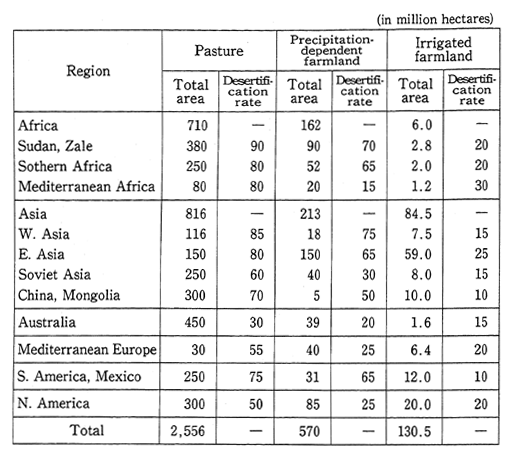
As the population of developing countries is likely to rise in the future, it is predicted that desertification will go on in the pastures virtually at the same pace as at present and accelerate in farmland of the sort which depends on rainfall, and it is projected that particularly in tropical regions--notably in the Sahel district which is situated at the southern edge of the Sahara Desert, the Andes in South America and India and Nepal in South Asia--the danger is greatest for the farmland which is reliant on rainfall.
There remain many uncertainties about the progress of deser-tification around the world and how serious it is, and new assessments must be made on the basis of the latest data. For this, the FAO is working for the development of a remote-sensing observation system via satellites. The UNEP also studies assessment methodologies and plans to come out with a report on desertification around the world by 1992.
The soil erosion is closely tied in with desertification. It repre-sents the phenomenon in which the topsoil is lost by wind and rain and stimulates desertification in the dry area and inflicts damage on farm production, among others, in areas other than the dry area. Cultivation on the slopes, inappropriate felling methods, inappropriate farming methods and the like are cited as causative factors for a soil erosion.
In respect of the soil erosion, the soil which is lost a year is 16 billion tons greater than the soil which is newly generated a year in the whole world. And it is projected that the world's major grain-producers, including the United States, the Soviet Union, India and China, account for half of the total loss. The soil erosion which is caused by a decrease in the acreage of forests in the mountainous Nepalese region is one of the causes to the floods which hit Bangladesh every year.
(6) Decreasing Species of Wildlife
The surface of the earth is called the biosphere and is the only space for mankind's existence. Wild fauna and flora form extensive and diversified ecosystems in the physical environment of the biosphere which, after all, is a thin layer. Wildlife as a total is an important existence which generally contributes to maintain the balance of the natural environment, such as the circulation of energy and substances. It forms the basis for mankind's biological existence and offers bless-ings in arts, science and culture.
When considering wildlife from its direct benefit to mankind, wildlife per se is indispensable for human life as resources for food, fuels, clothing, ornaments and medicines. Although many agricultural products, such as rice and vegetables are species artificially raised and it is certain that man does not necessarily eat only wild species, it is to be noted that the genes of the wild species are put to use at the beginning stage and in the course of improvements in all species under cultivation. In order to make possible the development of medicines and other projects in coping with increase of the world's population, climatic and other environmental changes and new diseases, it might be said that there is no alternative but to conserve the diversity of genes, species and ecosystems, which are products from the process of evolution of life on the earth. Even if one does not consider them as resources, it is also a direct benefit that wildlife assures a prosaic life of man as subjects of outdoor recreation and pets.
Ever since life came on the earth about four billion years ago, many species were born in the evolution process on the one hand, and on the other, many species have been extinct because of meteorological and topographical changes or of their defeat in struggles for existence in species. The extinction of species has always taken place in the process of nature. However, present extinction goes on at a faster speed than ever since the beginning of world history. It is not because of the process of nature but because of mankind's various behavior.
Tabl 1-1-15 Causes to Extinction of Species After 1600
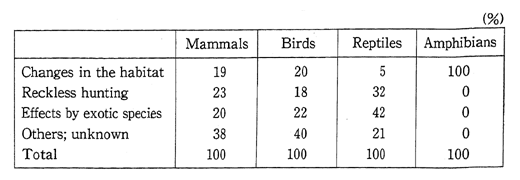
Source: IUCN, Endangered Species Handbook, 1983
According to a report released by the International Union for Conservation of Nature and Natural Resources (IUCN) in 1986 (Table 1-1-15). direct causes of the extinction of wildlife are a deterioration of the habitat, reckless hunting, impacts from invading species and other factors, in order. The deterioration of the habitat is grave in the tropical forests, on the coral reefs, in the marshes and on the islands. Above all, the decrease of tropical rain forests, which are described as a treasure house for wildlife, presumably produces significant effects on the deple-tion of wild species.
The increase of harmful ultraviolet rays and climate change in conjunction with rises in the concentration of greenhouse gases are considered as new factors which might adversely affect the existence of species in the future.
Let us review the philosophy of international and other institu-tions about the conservation of species. The Declaration on the Human Environment at the U.N.Conference on the Human Environment in 1972 said, "Man has a special responsibility to safeguard and wisely manage the heritage of wildlife and its habitat which are now gravely imperilled by a combination of adverse factors. Nature conservation including wildlife must therefore receive importance in planning for economic development."
The basic concept was also shown in the preamble of the CITES (the Convention on International Trade in Endangered Species of Wild Fauna and Flora) [Washington Convention], adopted in Washington, D. C., in 1973, which declared,"··· wild fauna and flora in their many beautiful and varied forms are an irreplaceable part of the natural ecosystems of the earth which must be protected for this and the generations to come." The report released in 1987 by the World Com-mission on the Environment and Development under the title of Our Common Future said that "Species and their genetic materials promise to play an expanding role in development, and a powerful economic rationale is emerging to bolster the ethical, aesthetic, and scientific cases for preserving them," pointing out the importance of the species of wildlife and its genes as resources for the breed improvement of crops, medicines and other products, and it went on to say, "The Earth' s endowment of species and natural ecosystems will soon be seen as assets to be conserved and managed for the benefit of all humanity. This will necessarily add the challenge of species conservation to the interna-tional political agenda."
There are several surveys on the state of wild species. The number of identified species (those whose scientific names are deter-mined) is said to be 1.5-1.7 million, but the number of species existent on the globe is considered to be five million to more than 10 million and some experts insist that it exceeds 30 million.
Table 1-1-16 provides data from the IUCN and other institutions. The number of species on the globe has increased as there has been progress in studies on insects and organisms on the deep seabed in recent years. The difference between the estimated figures of five million and 30 million stems primarily from the difference in the projected figures of insects. The distribution of species on the globe by climatic zone indicates that the frigid zone accounts for 6%, the temper-ate zone 59% and the tropical zone 35%, but the pace of taxonomical studies in the tropical zone is so slow that it is risky to consider the distribution by climatic zone merely on the basis of identified species. In terms of projected figures, the frigid zone accounts for 1-2%, the tem-perate zone 13-24% and the tropical zone 74-86%. Tropical rain forests occupy a mere 7% or so of the earth's surface, but it is thought that about half of all species on the globe depend on them.
Table 1-1-16
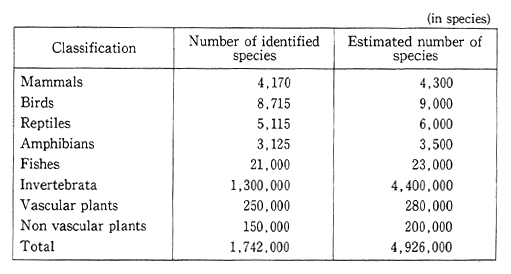
Source: World Resources, 1986
According to the IUCN's red list and other surveys, 3,117 species of fauna and 15,870 species of flora were believed to be on the verge of extinction in 1986. Roughly 3,000 species of fauna and 30,000 species of flora are listed in the appendix of the CITIES. In C. Meyer's "The Sinking Ark" , the IUCN's "World Conservation Strategy "in 1980 and U.S. State Department's "The Globe in 2000," (Table 1-1-17) the number of species to be extinct before 2000 is projected at 500,000 to one million or more. This projected figure largely exceeds the number of species on the IUCN's red list or the species listed under the CITES, because the extinction of small animals--particularly, mollusks, insects and other spineless animals--is projected in certain methodologies and they are included among the species which are to be extinct.
It will be impossible to regenerate the species which exist on the globe at present, once they are extinct, so that it is indispensable to conserve them in a renewable manner and to use them for mankind's existence in the renewable manner. Highly endangered species are enumerated in the IUCN's red list and the appendix of the CITES and it is necessary to avoid their extinction through international under-standing and coordination.
Table 1-1-17 Projected Extinction of Flora and Fauna by 2000
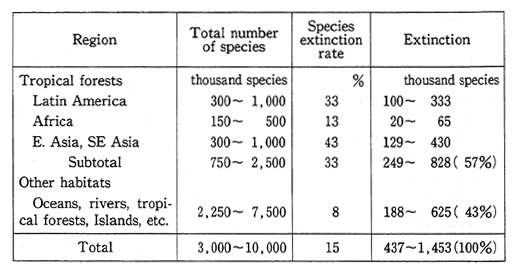
Source: U.S. Government's Special Survey Report "The Globe in 2000"
Note: Cases with the lowest forest reduction rate
Japan became a party to the CITES and other pacts, and enforced a Law for the Regulation of the Transfer of Endangered Species of Wild Fauna and Flora in December 1987 to maintain an effective implementa-tion of the convention. By the above law, Japan restricts the domestic transaction of wild fauna and flora which are likely to be extinct because of excessive international trade.
Nonetheless, the depletion of species goes on at the fastest pace in tropical regions which feature the richest diversity of species. In particular, the depletion of wild species is spurred in tropical rain forests, which are considered as a treasure house for wild organisms. The primary cause of the drastic depletion of species in tropical regions is the rapidly ongoing depletion and deterioration of forests, and there are many difficult problems to solve in regard to the adjustment of development with the conservation of species and other factors.
Given this situation, UNEP has started studies on new legal instrument, including conventions, for the promotion of a comprehen-sive policy for the conservation of biological diversity.
(7) Pollution of Oceans and International Rivers
In addition to pollutants which flow into the seas by way of rivers or directly from the coast, a wide variety of pollutants are released into the seas due to the navigation of ships and their mishaps and the development of oil fields on the seabed, etc. According to the findings of a survey conducted by the Intergovernmental Oceanographic Commis-sion (IOC) of the UNESCO and the World Meteorological Organization (WMO) released in 1982, almost all cases of oil pollution were observed on the Bay of Mexico, along the routes of Japanese tankers and along the routes of tankers between the United States and Europe. Oil pollu-tion will sometimes inflict significant damage on birds, marine mam-mals and other wild organisms, the tourist industry and fisheries, etc. Regarding the global effect, there is the possibility that oil soread over the sea surface would produce impacts on the circulation of water and air on the globe.
In conjunction with an increase in the output of plastics, the pollution of oceans by plastic waste has been posed as an international issue. The Meteorological Agency has been conducting eye-observation surveys on oceanic flotage on the Western Pacific to discover it in almost every surveyed sea area. According to an eye-observation survey performed by the Fisheries Agency in the sea areas near and off the Japanese coasts, flotage was observed on almost all the surveyed area. In this survey, polystyrene foam accounted for 22% and other plastics 23%,indicating that pollution by plastic waste was conspicuous. Accord-ing to surveys conducted on the Northern Pacific from 1970 to 1979, plastics were extracted from the stomachs of 193 of 218 sooty shear-waters (Pufiinus grisesus) and 265 of 324 slender-billed shearwaters (P. tennirostris), and there is concern about a degeneration of their propagating power and abnormalities in their behavior.
Furthermore, in regard to the pollution of oceans by chemicals, there have recently been survey reports on the pollution of the open seas and whales and other wild organisms with BHC, DDT, PCB and other chemicals. In surveys on BHC and DDT, high values have been observed in areas intermediate in latitude in the Northern Hemisphere where the production and consumption of chemicals are concentrated, and though there is little progress in the pollution of the Southern Hemisphere, there is a danger that pollution might spread to tropical areas low in latitude.
Given those conditions, the Convention on the Prevention of Marine Pollution by Dumping of Wastes and Other Matter (London Dumping Convention), which controls the dumping into the seas of wastes which is generated mainly on the land, and the Protocol of 1978 Relating to the International Convention for the Prevention of Pollution From Ships, 1973 (MARPOL 73/78 Convention), which controls the discharge of oil, noxious liquids and garbage from ships are in effect to prevent marine pollution. Under the MARPOL 73/78 Convention, con-trols on oils were put into force in 1983, controls on noxious liquid substances in bulk in 1987, and controls on garbage in 1989.
In March 1989, crude oil was gushed out in massive quantities from a tanker which had run aground in the Bay of Alaska, giving rise to a large-scale accident of oceanic pollution due to a delay in the control of the outflow and inflicting serious damage on sea otters and other mammals, oceanic birds and fish. Given this development, the International Maritime Organization (IMO) was asked by the Arche summiteers to formulate plans for the prevention of oil pollution inci-dents. In response to this request, the International Convention on Oil Pollution Preparedness, Response and Cooperation, 1990 (the OPRC Convention) with a view to establishing a system of international coordination was adopted at the IMO in November 1990.
The pollution of regional seas hemmed in by a number of coun-tries is also posed as a problem of international environmental pollution. Particularly in the North Sea surrounded by some of the world's most prominent industrial countries, there has been concern about the impacts produced on ecosystems by the inflow of a wide variety of heavy metals, chemicals, oils and nutrient salts, and in the summer of 1988, large numbers of fish and seals died for unaccounted reasons. In the Baltic, the Mediterranean and other seas, pollution is also at issue. For conservation of the ecosystems of those regional seas, UNEP worked on the countries which shared those seas to take common measures. As a result, programs for the conservation of 11 regions in the world have been formulated by more than 130 countries and 14 U.N. and regional organizations, and efforts are being made, such as research, monitoring and the reduction of pollution loads.
Like marine pollution, the pollution of riparian water is also important, and international cooperation has been rendered primarily by coastal countries to conserve the water quality of international rivers. For example, the water quality of the Rhine which runs through Western Europe was deteriorated due to economic development and population increase of its basin. In the early 1970s, fish was brought up to the water surface and other damage was caused due to a lack of dissolved oxygen (DO), and as there was a rise in the discharge of heavy metals and organic chemicals, there arose concern about impacts on drinking water. Given this development, Switzerland, France, West Germany, Luxembourg and the Netherlands established an Interna-tional Commission for the Protection of the Rhine Against Pollution and adopted a Rhine Chemical Treaty and a Treaty for the Protection of the Rhine against pollution by chlorides. As a result of such international cooperation, the water quality has been improved to 80% of the normal value in terms of the quantity of dissolved oxygen, and the concentra-tion has decreased for almost all heavy metals. But further efforts are required for the purification of the Rhine.
(8) Control of Chemicals and Transboundary Movement of Hazardous Wastes
a. Control of Chemicals
In conjunction with the development of the chemical industry, tens of thousands of varieties of chemicals are industrially produced, and the amount of chemicals produced is increasing at a strikingly fast pace. And a wider variety of chemicals have become used in various sectors, including those closely related to citizens' daily lives. Given such factors as rises in the utilization of chemicals, there are increased opportunities for the discharge of chemicals into the environment, and some chemicals like PCB and other organochlorine agents are respon-sible for pollution on a global scale, and environmental pollution by chemicals is now a common grave problem not just in Japan but everywhere in the world.
One of the causes to environmental pollution by chemicals is their massive and extensive use without a full assessment of potential impacts on health and the environment, and the evaluation of effects by chemicals and the thoroughgoing control of all processes, including production, distribution, use and disposal, have become important. Systems have been developed whereby reporting is obligated in Eur-opean and American countries and Japan, on the safety of new chemi-cals before their production, import or marketing.
In light of major accidents for which chemicals are responsible, systems are developed in the United States on reporting on responses to accidents and the amount of chemicals in stock, etc. The Organization for Economic Cooperation and Development (OECD) and other interna-tional organizations have taken such measures as adopting the system of reporting on new chemicals prevention and response to large-scale accidents, assessment of the safety of chemicals, exchanges of informa-tion about the control of chemicals, researches and studies in each country, and the cooperative work to collect data on environmental safety tests on existing chemicals shared by each country, etc. From a standpoint of providing appropriate information to developing coun-tries, recommendations are made on the provision of information in exporting or importing chemicals on whose production are under strict controls.
A large amount of chemicals are produced in the world, the international distribution of chemicals has been increased and there are concerns that environmental pollution by chemicals might steadily spread all over the world, so in order to prevent environmental pollution by chemicals beside national responses by each country, it is now an important task to work for the international monitoring of environmen-tal pollution, the updating of information about the safety of chemicals and the strengthening chemicals management by international coopera-tion.
b. Transboundary Movement of Hazardous Wastes
The transboundary movement of hazardous wastes has been nothing uncommon in Europe each country of which is connected by land. Even today, 2 million tons of hazardous wastes are disposed of across the borders for all the OECD-member countries, and in addition to exports to East Germany, Hungary, Yugoslavia and other East European nations which suffer from a lack of hard currency, it has been recently found that hazardous waste matter migrates across the borders of Turkey and other Middle East countries.
Causes of the transboundary movement of hazardous wastes include:1. Rising costs of disposal in the home country; 2. Diminishing capacity for disposal of certain types of wastes in the home country ; 3. Potential future liability for any damages by wastes disposed into or onto land in the home country; 4. Tightening of laws, regulations and policies concerning disposal of certain types of wastes, e.g., prescriptive disposal routes, such as incineration being required for liquids contain-ing certain organic substances; 5. Tightening of laws, regulations and policies governing on-site disposal operations for wastes performed by a generator on his own premises; 6. General economic growth which may result in more total generation of wastes ; 7. Existence of disposal facilities which may serve several countries ; 8. Market opportunities for materials which can be recovered, reclaimed or recycled from wastes otherwise destined for "final" disposal ; and 9. Existence of an appropriate disposal facility in a foreign country which is closer than a similar facility in the home country. It is thought that hazardous wastes which need high-level disposal at special plants are exported to develop-ing countries where controls are not severe and disposal costs are cheap.
In Europe, the transboundary movement of hazardous wastes became an issue in the early 1980s as a result of the occurrence of accidents, such as a case in which the soil contaminated with dioxin generated in an explosion at an Italian pesticide plant (the Seveso incident) was initially disappeared but were found in northern France eight months later. The OECD and the European Community (EC) came out with decisions, recommendations and directives obligating the exporters of hazardous wastes to inform and get permission from the governments of the exporting and importing countries.
In the late 1980s, however, toxic waste was exported from Western countries to developing countries in Africa and South America without confirmation of its legitimate disposal and there appeared many cases where it was illegally brought in or left as it was, thus making the transboundary movement of hazardous wastes a global issue which transcends national borders. The typical examples include a case in which a British corporation tried to bring 1,500 tons of hazardous wastes into Guinea Bissau, which had trouble in repaying foreign debts, at a contract price double the debts, and another case in which an Italian firm dumped PCB and other hazardous wastes in Nigeria.
In light of those incidents, UNEP formulated a basic guideline on the legitimate control of hazardous wastes (Cairo Guideline). The Organization of African Unity (OAU) adopted a resolution in 1988 under which a ban would be put on the conclusion of agreements or contracts with foreign governments or enterprises on the disposal of hazardous wastes in Africa. Given those developments, the efforts made by the OECD and the countries made it possible to adopt a Basel Convention on the Controls of Transboundary Movements of Hazardous Wastes and their Disposal in March 1989, which provided for a system of notification of exports and imports and the measures which would be taken in the case of an illegal transboundary movement. Japan is making necessary studies for an early accession to the convention.
(9) Environmental Pollution in Developing Countries
Industrial product in developing countries has strikingly in-creased as they have stepped up industrialization for economic develop-ment. In the initial phase, industrialization was promoted mainly on the light industry but the emphasis was gradually shifted to the heavy and chemical industries, such as petrochemical and metal industry. As those industries with heavy environmental loads have been constructed, indus-trial pollution came to the fore. Besides, continuous population growth at fast rates in developing countries has constituted a cause to the deforestation of tropical forests, thus leading people who were no longer able to maintain living in the rural areas to massively migrate to cities and rapidly accelerating the concentration of population in the urban areas.
As a result, slums extensively cropped up to deteriorate the living environment and the health conditions, and pollution associated with livelihood was on the upswing. As industrialization and the concentra-tion of population were so rapid that pollution came to be extensively observed in newly industrializing economies (NIEs). In other developing countries, the sanitary conditions deteriorated by poverty constitute yet another grave problem beside the deterioration of the environment by industrialization.
Fig. 1-1-18 Concentrations of Sulfur Oxides in Major World Cities
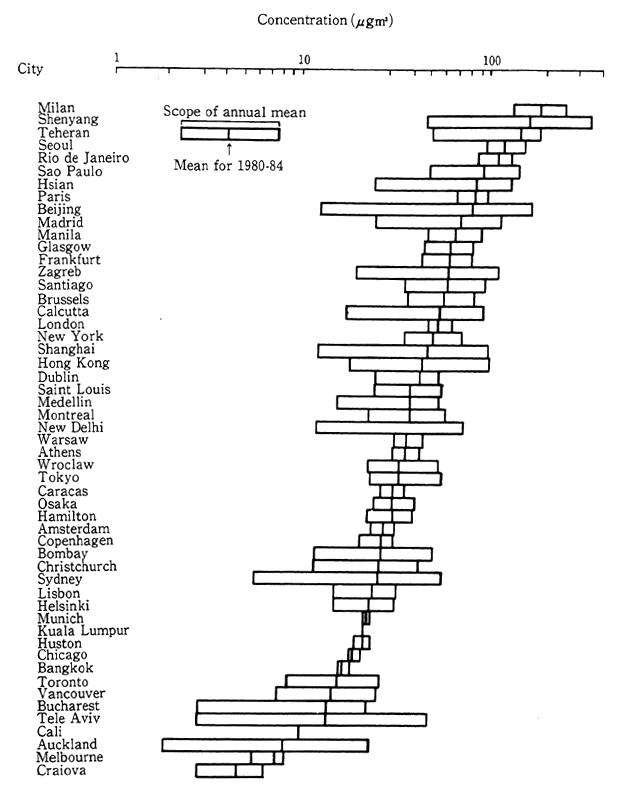
Source: UNEP data.
Fig. 1-1-19 Annual Average Changes in Concentration of Sulfur Oxide in Major World Cities
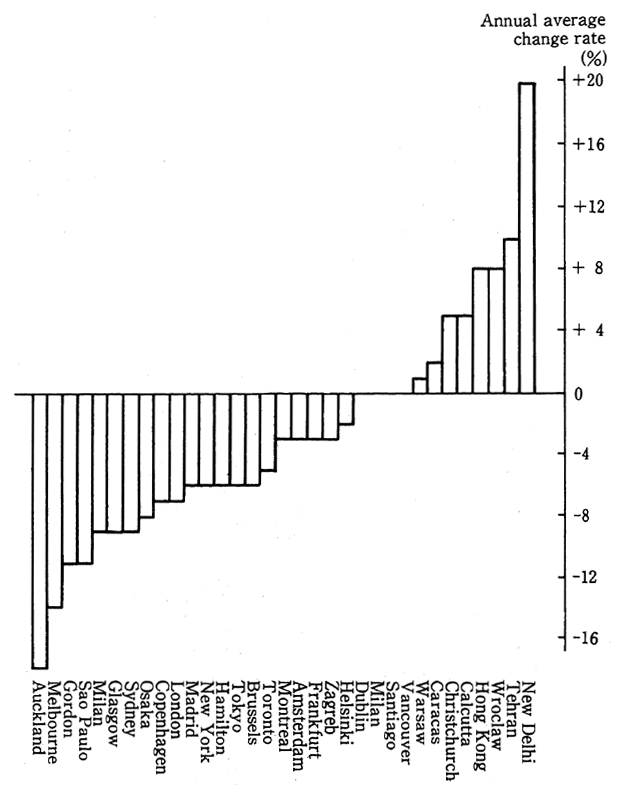
Source: UNEP data.
First, in respect of air pollution, the data collected by the monitoring network of the UNEP and the World Health Organization (WHO) in major world cities indicate that the concentration of sulfur dioxide in developing countries' cities is the same as or higher than that in cities of industrialized countries, and seven of the top 10 cities around the world are those in developing countries (Fig. 1-1-18). The same thing may be said of suspended particulate matter. In Mexico City, the suction of suspended particlulate matter a day corresponds to the smoking of 40 cigarettes. In many cities in industrialized countries, there are signs of an improvement, whereas there are signs of a gradual aggravation in developing countries' cities (Fig. 1-1-19).
In regard to the water quality, problems are posed by the inade-quate treatment of waste water or the permeation of pesticides into the underground water and its release into rivers. It is pointed out in the UNEP's Environmental Conditions in the World in 1989 that of all monitoring points in the UNEP/WHO monitoring network, the Ruiji River in Tanzania (with dieldrin at 3.0 micrograms/liter), the GANCA JANCHITO River in Colombia (with DDT at 0.3 microgram/liter), the GOMBAK River in Malaysia (with dieldrin at 30.6 micrograms/liter), all monitoring points (with PCBs at 0.4-6.9 micrograms/liter) in Indonesia and rivers in developing countries registered upwards of 1 microgram/ liter of air pollution by organic chemicals.
In order to cooperate in dissolving environmental pollution in developing countries, Japan has continued to offer yen loans, render grants cooperation, dispatch experts, accept trainees and conduct devel-opment studies, etc., but it is hoped that Japan will further step up cooperation as it is equipped with advanced technology and financial resources.
3. Global Environment Issue as Interaction of Various Environmental Problems
As we have seen in the foregoing, the global environment prob-lems have come to the fore in various aspects. Those problems are caused on the common ground of human activity and interrelated with one another, thereby constituting a series of problems on global eco-systems (Fig. 1-1-20).
Those global environmental problems are basically caused by the excessive loads from the quantitative expansion and qualitative changes of human activity. The state of the earth today has been formed as many as 4.6 billion years since it came into being. It is composed by a wide variety of matter and in a complex circulation of ecosystems. There exists an exceedingly delicate balance.
With the Industrial Revolution as a turning point, the striking expansion of human activity and the population increase have made significant loads on the global environment. The increased emission of carbon dioxide responsible for global warming and the acid rain is a typical problem associated with a quantitative expansion of human activity. The deforestation of tropical forests, ongoing desertification and the decrease of biodiversities are mainly caused by loads on land with subtle ecosystems which have been increased with expansion of human activity and the population growth.
Fig. 1-1-20 Problems on Global Environment as Group of Issues
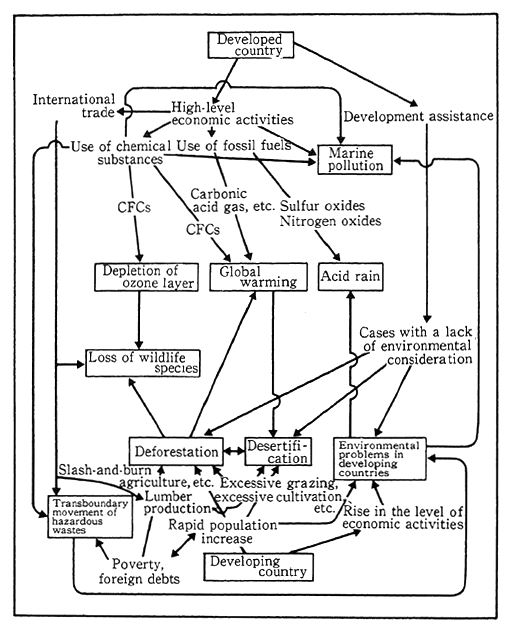
The population increase in developing countries stems in large measure from poverty in developing countries, associated with their social structure itself. Besides, as it is closely tied in with the world economy as a whole in which there is a growing interdependence, the economic performance of industrialized countries is never unrelated. The depletion of the ozone layer by CFCs, pollution by chemicals and the transboundary movements of hazardous wastes are caused by the massive and extensive use of a wide variety of substances newly developed by humans in conjunction with an expansion of the economic performance.
Each global environmental problem is also interrelated. For example, CFCs which deplete the ozone layer is one of the causative substances responsible for global warming, whereas deforestation accel-erates global warming with a decrease in the sink of carbon dioxide. With ongoing global warming, there is a danger that changes in vegeta-tion might not catch up with climate change, and the precipitation pattern will be changed, the forests weakened and desertification ac-celerated. The deforestation of tropical forests is the primary cause to the depletion of wild species. Marine pollution deters the absorption by the seas of carbon dioxide and accelerates global warming.
Thus, there are many aspects where one problem concerning the global environment causes, or results from, yet another problem on the global environment. On the other hand, the use of CFCs not harmful to living bodies has increased in place of trichloroethylene and other organochlorine solvents which have given rise to the pollution of ground water both in Japan and in other countries, but CFCs themselves are now a causative material for depletion of the ozone layer, suggesting that a technical response to the solution of an environmental problem paves the way for the appearance of yet another environmental prob-lem.
Therefore, global environmental problems crop up while a wide variety of problems is interrelated. Besides, it is to be noted that they generally have the nature that their impacts appear after extremely long spans of time. The ecosystems which surround the earth exist on a delicate balance, and it will be extremely difficult to restore this balance, once it is fallen apart. Consequently, if the present generation does not make efforts to come out with steady measures and the environment is allowed to be deteriorated on a global scale, many burdens will eventually be imposed on the next generation for an improvement of the deteriorated environment or the next generation will be tormented by a hardly retrievable environment.
In this context, it is necessary to comprehensively step up conser-vation of the global environment in a long-term perspective which transcends the generations.
II. Energy and the Environment
Energy is indispensable for our life which includes food, shelter and transportation. In addition, it forms the basis for information and communication as well as the production and distribution of commod-ities. Thus, it cannot be spared for human activity. It is not too much to say that the modern civilization has been developed by mankind with a massive consumption of energy.
Yet in another aspect, energy imposes a wide variety of loads on the environment which is the place of human activity in conjunction with development, manufacture, consumption and disposal, etc., and which forms the foundation for the existence of all living things.
Above all, oil, coal, natural gas and other fossil fuels are closely tied in with issues on the environment. In the combustion, storage and other phases, first, sulfur oxide, nitrogen oxide, soot and dust, hydrocar-bon and many other air pollutants are discharged, causing regional air pollution and acid rain. For oil fields on the seabed, once a major accident occurs, the ocean is seriously polluted as was the case with the North Sea oil field. The crude oil spilled in the accidents of huge tankers and ballast water in their cargo holds are also causes for marine pollution.
Moreover, fossil fuels emit carbon dioxide which causes global warming during the course of their combustion. They also release nitrogen oxide and other chemicals. Methane is emitted in the digging process and leaked in the shipping process.
For the location of power generation plants which use terrestrial heat, hydraulic power and other types of energy, it is to be hoped that measures be taken for their harmonization with the natural environ-ment. The urban consumption of energy will sometimes become a cause for heat islands.
Many developing countries rely on firewood and other biomass energy for the greater portion of energy they consume. The excessive collection constitutes a cause for deforestation and desertification.
Thus, it is necessary to pay appropriate consideration at all times to loads on the environment in the development and use of energy.
1. Environmental Problems in Energy Consumption
First, let us look at problems on environmental pollution in association with energy consumption.
(1) Regional Air Pollution by Soot and Dust, Sulfur Oxides, Nitrogen Oxides and Other Chemicals
Potentially, the combustion of fossil fuels may result in the emission of a wide variety of air pollutants. The environmental problem which was highlighted for the first time in Japan in conjunction with energy consumption concerned air pollution by soot and dust which were generated by the combustion of oil and coal.
In the postwar reconstruction of the Japanese economy, air pollution by soot and dust came to the fore, and the Tokyo Metropolitan Government enacted an Ordinance for Prevention of Pollution by Indus-trial Plants already in 1949. Of all soot and dust, those which were large in particle diameter and fell on the ground were monitored as the fallout of dust and soot. The air pollution caused by them was serious from 1955 to 1970, but great improvements were made later (Fig. 1-2-1).
Fig. 1-2-1 Trends in Fallout of Dust and Soot in Kawasaki City
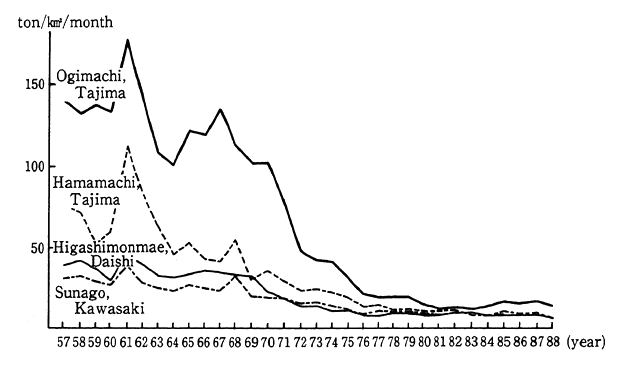
Those soot and dust which are less than 10 microns in particle diameter float in the atmosphere over long spans of time and are likely to deposit in the respiratory track or pulmonary alveoli, producing impacts on the lungs, so that EQS are determined for them as suspended particulate matter, but the degree to which those standards have been satisfactorily achieved is low.
Coal, oil and other sulfur-containing fossil fuels generate sulfur oxides in the course of their combustion. Japan experienced a serious air pollution caused by sulfur oxides. With energy consumption on the upswing (three times over 10 years), production by mining and manufac-turing industries which centered on heavy and chemical industries rapidly expanded with energy consumption on the upswing (Fig. 1-2-2). The consumption of oil, constituting the bulk of the increase in energy demand, was concentrated in specific industrial zones, giving rise to a serious air pollution with sulfur oxides.
Given this development, a Law Concerning Controls on the Emissions of Soot and Smoke was enacted in 1962, turning out to be Japan's first law for the prevention of air pollution. In 1968, an Air Pollution Control Law was enacted. Nonetheless, air pollution with sulfur oxides was further serious and patients with respiratory diseases caused by air pollution were on the upswing. For a prompt remedy, a Law Concerning Special Measures for the Relief of Pollution-related Patients was enacted in 1969 and superseded by a Pollution-related Health Damage Compensation Law in 1974 (redesignated as the Law Concerning Pollution-related Health Damage Compensation and Pre-vention in 1985). Later, air pollution by sulfur oxides was strikingly alleviated, and the designation of areas for air pollution-related health damage compensation is canceled on the basis of a scientific assessment that air pollution was no longer considered to be a main cause for the prevalence of asthma and other ailments.
Fig. 1-2-2 Trends in Rate of Industries to Real Domestic Gross Product
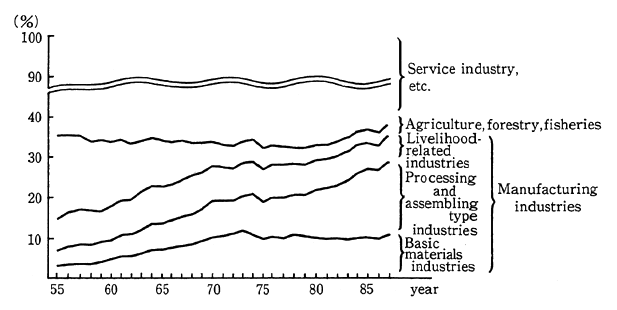
Notes: 1. Annual Report on National Account.
2. The basic materials industries include paper and pulp, ceramic, soiland stone, chemical, petroleum and coal product, primary metal and metal product industries. The processing and assembling industries include general machinery, electrical machinery and transportation machinery precision machinery industries. The livelihood-related industries include food, textile and other manufacturing industries.
Nitrogen in fossil fuels turns into nitrogen oxides in the process of their combustion. As high temperature is generated by combustion, nitrogen in the atmosphere is oxidized in the combustion process to generate nitrogen oxides.
With a peak in 1978, the atmospheric concentration of nitrogen dioxides in the environment had decreased, but it has been a tendency to increase since 1986. Even in 1988, the concentration was in excess of EQS in some major cities with an increase in the automobile traffic volume. For this reason, air pollution by nitrogen dioxide is now a grave issue (Fig. 3-1-1 and Fig. 3-1-2).
Caused by carbon monoxide, nitrogen oxides and hydrocarbon which are generated by the incomplete combustion of fuels, photochemi-cal oxidants poses problems on regional air pollution in conjunction with energy consumption.